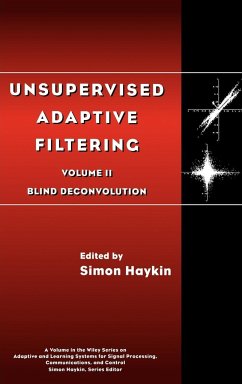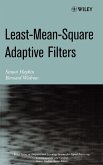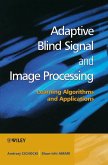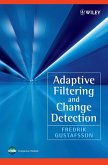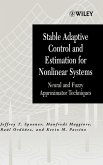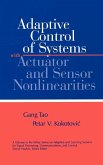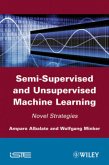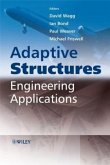- Gebundenes Buch
- Merkliste
- Auf die Merkliste
- Bewerten Bewerten
- Teilen
- Produkt teilen
- Produkterinnerung
- Produkterinnerung
Unüberwachte adaptive Filterung bedeutet, daß das System automatisch auf Veränderungen der Bedingungen reagiert: Die Filter können sich verschiedenen Situationen anpassen, ohne daß ein Mensch eingreifen müßte. Hunderte von Beiträgen zu diesem äußerst aktuellen Forschungsfeld sind in der Fachpresse erschienen. Dieser Band faßt den derzeitigen Erkenntnisstand zusammen und erspart Ihnen damit eine zeitraubende Recherche. (04/00)
Andere Kunden interessierten sich auch für
![Least-Mean-Square Adaptive Filters Least-Mean-Square Adaptive Filters]() Simon HaykinLeast-Mean-Square Adaptive Filters191,99 €
Simon HaykinLeast-Mean-Square Adaptive Filters191,99 €![Adaptive Blind Signal and Image Processing Adaptive Blind Signal and Image Processing]() Andrzej CichockiAdaptive Blind Signal and Image Processing208,99 €
Andrzej CichockiAdaptive Blind Signal and Image Processing208,99 €![Adaptive Filtering and Change Detection Adaptive Filtering and Change Detection]() Fredrik GustafssonAdaptive Filtering and Change Detection201,99 €
Fredrik GustafssonAdaptive Filtering and Change Detection201,99 €![Stable Adaptive Control and Estimation for Nonlinear Systems Stable Adaptive Control and Estimation for Nonlinear Systems]() Jeffrey T. SpoonerStable Adaptive Control and Estimation for Nonlinear Systems182,99 €
Jeffrey T. SpoonerStable Adaptive Control and Estimation for Nonlinear Systems182,99 €![Adaptive Control of Systems with Actuator and Sensor Nonlinearities Adaptive Control of Systems with Actuator and Sensor Nonlinearities]() Gang TaoAdaptive Control of Systems with Actuator and Sensor Nonlinearities191,99 €
Gang TaoAdaptive Control of Systems with Actuator and Sensor Nonlinearities191,99 €![Semi-Supervised and Unsupervised Machine Learning Semi-Supervised and Unsupervised Machine Learning]() Amparo AlbalateSemi-Supervised and Unsupervised Machine Learning164,99 €
Amparo AlbalateSemi-Supervised and Unsupervised Machine Learning164,99 €![Adaptive Structures Adaptive Structures]() Michael Friswell / David Wagg / Ian Bond / Paul Weaver (eds.)Adaptive Structures138,99 €
Michael Friswell / David Wagg / Ian Bond / Paul Weaver (eds.)Adaptive Structures138,99 €-
-
-
Unüberwachte adaptive Filterung bedeutet, daß das System automatisch auf Veränderungen der Bedingungen reagiert: Die Filter können sich verschiedenen Situationen anpassen, ohne daß ein Mensch eingreifen müßte. Hunderte von Beiträgen zu diesem äußerst aktuellen Forschungsfeld sind in der Fachpresse erschienen. Dieser Band faßt den derzeitigen Erkenntnisstand zusammen und erspart Ihnen damit eine zeitraubende Recherche. (04/00)
Produktdetails
- Produktdetails
- Adaptive and Cognitive Dynamic Systems: Signal Processing, Learning, Communications and Control 2
- Verlag: Wiley & Sons
- 1. Auflage
- Seitenzahl: 200
- Erscheinungstermin: 6. April 2000
- Englisch
- Abmessung: 240mm x 161mm x 15mm
- Gewicht: 465g
- ISBN-13: 9780471379416
- ISBN-10: 0471379417
- Artikelnr.: 09472972
- Herstellerkennzeichnung
- Libri GmbH
- Europaallee 1
- 36244 Bad Hersfeld
- gpsr@libri.de
- Adaptive and Cognitive Dynamic Systems: Signal Processing, Learning, Communications and Control 2
- Verlag: Wiley & Sons
- 1. Auflage
- Seitenzahl: 200
- Erscheinungstermin: 6. April 2000
- Englisch
- Abmessung: 240mm x 161mm x 15mm
- Gewicht: 465g
- ISBN-13: 9780471379416
- ISBN-10: 0471379417
- Artikelnr.: 09472972
- Herstellerkennzeichnung
- Libri GmbH
- Europaallee 1
- 36244 Bad Hersfeld
- gpsr@libri.de
SIMON HAYKIN, PhD, is University Professor and Director of the Adaptive Systems Laboratory at McMaster University.
Contributors vii
Preface xi
1 Introduction 1
Simon Haykin
1.1 Why Adaptive Filtering? 1
1.2 Supervised and Unsupervised Forms of Adaptive Filtering 2
1.3 Two Important Unsupervised Signal-Processing Tasks 3
1.4 Three Fundamental Approaches to Unsupervised Adaptive Filtering 6
1.5 Organization of Volume II 10
References 11
2 The Core of FSE-CMA Behavior Theory 13
C. R. Johnson, Jr., P. Schniter, I. Fijalkow, L. Tong, J. D. Behm, M. G.
Larimore, D. R. Brown, R. A. Casas, T. J. Endres, S. Lambotharan, A.
Touzni, H. H. Zeng, M. Green, and J. R. Treichler
2.1 Introduction 14
2.2 MMSE Equalization and LMS 22
2.3 The CM Criterion and CMA 41
2.4 CMA-Adapted-Equalizer Design Issues with Illustrative Examples 75
2.5 Case Studies 89
2.6 Conclusions 106
References 108
3 Relationships between Blind Deconvolution and Blind Source Separation 113
Scott C. Douglas and Simon Haykin
3.1 Introduction 113
3.2 Problem Descriptions 117
3.3 Algorithmic Relationships 122
3.4 Structural Relationships 129
3.5 Extensions 140
3.6 Conclusions 142
References 142
4 Blind Separation of Independent Sources Based on Multiuser Kurtosis
Optimization Criteria 147
Constantinos B. Papadias
4.1 Introduction 148
4.2 Problem Formulation and Assumptions 150
4.3 Review: The Single-User Equalization Problem 154
4.4 Necessary and Sücient Conditions for BSS 160
4.5 Unconstrained Criteria: The MU-CM Approach 162
4.6 Constrained Criteria: The MUK Approach 165
4.7 Numerical Examples 171
4.8 Conclusions 175
References 176
Index 181
Preface xi
1 Introduction 1
Simon Haykin
1.1 Why Adaptive Filtering? 1
1.2 Supervised and Unsupervised Forms of Adaptive Filtering 2
1.3 Two Important Unsupervised Signal-Processing Tasks 3
1.4 Three Fundamental Approaches to Unsupervised Adaptive Filtering 6
1.5 Organization of Volume II 10
References 11
2 The Core of FSE-CMA Behavior Theory 13
C. R. Johnson, Jr., P. Schniter, I. Fijalkow, L. Tong, J. D. Behm, M. G.
Larimore, D. R. Brown, R. A. Casas, T. J. Endres, S. Lambotharan, A.
Touzni, H. H. Zeng, M. Green, and J. R. Treichler
2.1 Introduction 14
2.2 MMSE Equalization and LMS 22
2.3 The CM Criterion and CMA 41
2.4 CMA-Adapted-Equalizer Design Issues with Illustrative Examples 75
2.5 Case Studies 89
2.6 Conclusions 106
References 108
3 Relationships between Blind Deconvolution and Blind Source Separation 113
Scott C. Douglas and Simon Haykin
3.1 Introduction 113
3.2 Problem Descriptions 117
3.3 Algorithmic Relationships 122
3.4 Structural Relationships 129
3.5 Extensions 140
3.6 Conclusions 142
References 142
4 Blind Separation of Independent Sources Based on Multiuser Kurtosis
Optimization Criteria 147
Constantinos B. Papadias
4.1 Introduction 148
4.2 Problem Formulation and Assumptions 150
4.3 Review: The Single-User Equalization Problem 154
4.4 Necessary and Sücient Conditions for BSS 160
4.5 Unconstrained Criteria: The MU-CM Approach 162
4.6 Constrained Criteria: The MUK Approach 165
4.7 Numerical Examples 171
4.8 Conclusions 175
References 176
Index 181
Contributors vii
Preface xi
1 Introduction 1
Simon Haykin
1.1 Why Adaptive Filtering? 1
1.2 Supervised and Unsupervised Forms of Adaptive Filtering 2
1.3 Two Important Unsupervised Signal-Processing Tasks 3
1.4 Three Fundamental Approaches to Unsupervised Adaptive Filtering 6
1.5 Organization of Volume II 10
References 11
2 The Core of FSE-CMA Behavior Theory 13
C. R. Johnson, Jr., P. Schniter, I. Fijalkow, L. Tong, J. D. Behm, M. G.
Larimore, D. R. Brown, R. A. Casas, T. J. Endres, S. Lambotharan, A.
Touzni, H. H. Zeng, M. Green, and J. R. Treichler
2.1 Introduction 14
2.2 MMSE Equalization and LMS 22
2.3 The CM Criterion and CMA 41
2.4 CMA-Adapted-Equalizer Design Issues with Illustrative Examples 75
2.5 Case Studies 89
2.6 Conclusions 106
References 108
3 Relationships between Blind Deconvolution and Blind Source Separation 113
Scott C. Douglas and Simon Haykin
3.1 Introduction 113
3.2 Problem Descriptions 117
3.3 Algorithmic Relationships 122
3.4 Structural Relationships 129
3.5 Extensions 140
3.6 Conclusions 142
References 142
4 Blind Separation of Independent Sources Based on Multiuser Kurtosis
Optimization Criteria 147
Constantinos B. Papadias
4.1 Introduction 148
4.2 Problem Formulation and Assumptions 150
4.3 Review: The Single-User Equalization Problem 154
4.4 Necessary and Sücient Conditions for BSS 160
4.5 Unconstrained Criteria: The MU-CM Approach 162
4.6 Constrained Criteria: The MUK Approach 165
4.7 Numerical Examples 171
4.8 Conclusions 175
References 176
Index 181
Preface xi
1 Introduction 1
Simon Haykin
1.1 Why Adaptive Filtering? 1
1.2 Supervised and Unsupervised Forms of Adaptive Filtering 2
1.3 Two Important Unsupervised Signal-Processing Tasks 3
1.4 Three Fundamental Approaches to Unsupervised Adaptive Filtering 6
1.5 Organization of Volume II 10
References 11
2 The Core of FSE-CMA Behavior Theory 13
C. R. Johnson, Jr., P. Schniter, I. Fijalkow, L. Tong, J. D. Behm, M. G.
Larimore, D. R. Brown, R. A. Casas, T. J. Endres, S. Lambotharan, A.
Touzni, H. H. Zeng, M. Green, and J. R. Treichler
2.1 Introduction 14
2.2 MMSE Equalization and LMS 22
2.3 The CM Criterion and CMA 41
2.4 CMA-Adapted-Equalizer Design Issues with Illustrative Examples 75
2.5 Case Studies 89
2.6 Conclusions 106
References 108
3 Relationships between Blind Deconvolution and Blind Source Separation 113
Scott C. Douglas and Simon Haykin
3.1 Introduction 113
3.2 Problem Descriptions 117
3.3 Algorithmic Relationships 122
3.4 Structural Relationships 129
3.5 Extensions 140
3.6 Conclusions 142
References 142
4 Blind Separation of Independent Sources Based on Multiuser Kurtosis
Optimization Criteria 147
Constantinos B. Papadias
4.1 Introduction 148
4.2 Problem Formulation and Assumptions 150
4.3 Review: The Single-User Equalization Problem 154
4.4 Necessary and Sücient Conditions for BSS 160
4.5 Unconstrained Criteria: The MU-CM Approach 162
4.6 Constrained Criteria: The MUK Approach 165
4.7 Numerical Examples 171
4.8 Conclusions 175
References 176
Index 181

